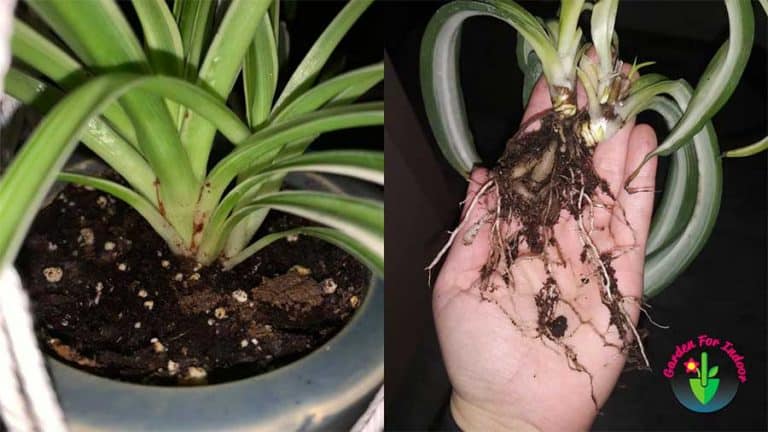That beautiful spider plant on your windowsill suddenly doesn’t look so lively. The leaves are yellowing and drooping. Is your plant a hopeless case or can it be saved? Learning to recognize the signs of spider plant root rot and taking prompt action is key to reviving your plant.
Telltale Signs Your Spider Plant Has Root Rot
Root rot often goes unnoticed at first since it develops under the soil. But close inspection of your plant can reveal these common symptoms:
- Leaves turning yellow or brown
- Wilting, drooping, or curling leaves
- Leaf tips browning
- Growth slowing or stopping
- Failure to bloom or produce offshoots
Gently slide your spider plant from its pot and check the roots. Healthy roots are firm, white, and spread outward. Black, brown, mushy roots that fall away easily signal root rot. The affected roots may be foul smelling or covered in mold.
Catching root rot early boosts your chances of saving your plant Left too long, the decay will spread, crippling your spider plant’s ability to absorb water and nutrients.
What Causes Spider Plant Root Rot?
Excess moisture is the leading cause of root rot in spider plants Overwatering suffocates the roots, creating an environment perfect for fungal or bacterial growth Root rot can also stem from
- Poor drainage from heavy soil or lack of drainage holes
- Potting in overly large containers
- Too much fertilizer accumulating in the soil
- High humidity
- Temperature extremes
Improper care like inadequate light, pests, and diseases may further stress the plant, making it more prone to rotting roots.
First Aid for Root Rotted Spider Plants
Don’t despair if your spider plant has root rot. With prompt treatment, it can bounce back. Here are some first aid steps:
Repot in fresh soil – Discard old rot-harboring soil. Sterilize pots before replanting.
Trim dead roots – Prune away all blackened, mushy roots with sterilized shears. Healthy white roots can remain.
Treat with hydrogen peroxide – Dilute 3% solution to 1 tbsp per cup of water. Drench roots to kill infection.
Hold off watering – Allow the soil to dry out completely before watering again to prevent further rot.
Move to a brighter spot – Improved light dries out the soil and stimulates recovery. Avoid direct sun which could scorch the weakened plant.
Propagate healthy offshoots – Rooted spider plant offshoots have the best chance of survival. Separate and repot them.
With attentive care, your spider plant should show signs of recovery within a couple weeks as new roots establish.
Preventing Spider Plant Root Rot
An ounce of prevention is truly worth a pound of cure when it comes to problematic root rot. Here are some tips to keep your spider plant’s roots happy and healthy:
-
Water only when the top inch of soil is dry. Stick to a consistent schedule.
-
Ensure pots have drainage holes to prevent waterlogging.
-
Use well-draining potting mixes, not dense garden soil.
-
Add perlite or gravel to improve drainage.
-
Empty water collecting in drainage trays after watering.
-
Maintain temperatures between 60°F-80°F.
-
Increase air circulation with fans to lower humidity.
-
Avoid overfertilizing which salts up the soil.
-
Repot annually in fresh soil to eliminate rot spores.
-
Inspect roots periodically for signs of decay.
-
Propagate spider plants routinely for insurance.
Healthy roots are vital to your spider plant’s ability to flourish. Stop root rot in its tracks by learning to quickly identify symptoms. Take prompt restorative measures at the first sign of trouble. With attentive care and optimal growing conditions, your spider plant will continue pumping out vigorous new growth for years to come.
My Spider Plant is Dying? What Do I Do?
FAQ
What does an overwatered spider plant look like?
What does the beginning of root rot look like?
Can a plant recover from root rot?
Can a spider plant get root rot?
The symptoms of Root Rot range from yellowing and falling of the leaves to wilting and stunted growth, as the plant is no longer able to absorb the nutrients it needs. A Spider Plant suffering from Root Rot can be saved if enough plant roots are still healthy. First, take the plant out of its pot and rinse the plant roots gently with running water.
How can I tell if my Spider Plant has root rot?
Root rot in Spider Plants is characterized by yellowing leaves and mushy roots. Although it can be difficult to detect because it occurs beneath the soil surface, proper lighting, repotting, and allowing the soil to dry can help save the plant.
Why is my Spider Plant turning yellow?
Overwatering is the primary cause of root rot as it suffocates the roots and constricts the oxygen flow resulting in damaged roots. Yellowing of leaves and mushy roots are common signs of root rot. Repotting the plant, providing appropriate lighting, and letting the soil dry out can help you save your spider plant.
How can you tell if a plant is rotting?
You may not be able to see root rot directly because it occurs beneath the soil. However, examining the leaves of the plant can help determine if the roots are rotting. Look for the following symptoms: Yellowing of leaves, appearance of brown spots on leaves, some leaves falling out, and signs of wilting.

